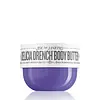What's inside
What's inside
 Key Ingredients
Key Ingredients

 Benefits
Benefits

 Concerns
Concerns

 Ingredients Side-by-side
Ingredients Side-by-side

Caprylic/Capric Triglyceride
MaskingCocoglycerides
EmollientWater
Skin ConditioningOctyldodecyl Myristate
EmollientOleyl Erucate
EmollientGlyceryl Stearate
EmollientGlyceryl Behenate
EmollientJojoba Esters
EmollientHelianthus Annuus Seed Cera
EmollientHydrogenated Castor Oil
EmollientBenzyl Alcohol
PerfumingPentylene Glycol
Skin ConditioningButylene Glycol
HumectantAcacia Decurrens Flower Cera
EmollientPolyglycerin-3
HumectantBisabolol
MaskingOctenidine Hcl
AntimicrobialHydroxyphenyl Propamidobenzoic Acid
Skin ConditioningTocopherol
AntioxidantGlyceryl Citrate/Lactate/Linoleate/Oleate
EmulsifyingVegetable Oil
Skin ConditioningAscorbyl Palmitate
AntioxidantZingiber Officinale Root Extract
MaskingCaprylic/Capric Triglyceride, Cocoglycerides, Water, Octyldodecyl Myristate, Oleyl Erucate, Glyceryl Stearate, Glyceryl Behenate, Jojoba Esters, Helianthus Annuus Seed Cera, Hydrogenated Castor Oil, Benzyl Alcohol, Pentylene Glycol, Butylene Glycol, Acacia Decurrens Flower Cera, Polyglycerin-3, Bisabolol, Octenidine Hcl, Hydroxyphenyl Propamidobenzoic Acid, Tocopherol, Glyceryl Citrate/Lactate/Linoleate/Oleate, Vegetable Oil, Ascorbyl Palmitate, Zingiber Officinale Root Extract
Water
Skin ConditioningButyrospermum Parkii Butter
Skin ConditioningCocos Nucifera Oil
MaskingEthylhexyl Palmitate
EmollientParfum
MaskingMethyl Glucose Sesquistearate
EmollientGlyceryl Stearate Se
EmulsifyingLauryl Laurate
Skin ConditioningGlycerin
HumectantMyristyl Myristate
EmollientHydrolyzed Sodium Hyaluronate
Skin ConditioningLactobacillus/Hibiscus Sabdariffa Flower Ferment Filtrate
Skin ConditioningCopaifera Officinalis Resin
MaskingPassiflora Edulis Seed Oil
EmollientPlatonia Insignis Seed Butter
EmollientTheobroma Grandiflorum Seed Butter
Skin ConditioningSqualane
EmollientTocopherol
AntioxidantBixa Orellana Seed Extract
MaskingCetearyl Alcohol
EmollientBehenyl Alcohol
EmollientCaprylic/Capric Triglyceride
MaskingPhenyl Trimethicone
Skin ConditioningMaltodextrin
AbsorbentCetearyl Olivate
Sorbitan Olivate
EmulsifyingSodium Stearoyl Glutamate
CleansingPotassium Cetyl Phosphate
EmulsifyingSodium Gluconate
Skin ConditioningEthylhexylglycerin
Skin ConditioningPhenoxyethanol
PreservativeButylene Glycol
HumectantCarbomer
Emulsion StabilisingPotassium Hydroxide
BufferingSodium Hydroxide
BufferingCI 75120
Cosmetic ColorantAlpha-Isomethyl Ionone
PerfumingWater, Butyrospermum Parkii Butter, Cocos Nucifera Oil, Ethylhexyl Palmitate, Parfum, Methyl Glucose Sesquistearate, Glyceryl Stearate Se, Lauryl Laurate, Glycerin, Myristyl Myristate, Hydrolyzed Sodium Hyaluronate, Lactobacillus/Hibiscus Sabdariffa Flower Ferment Filtrate, Copaifera Officinalis Resin, Passiflora Edulis Seed Oil, Platonia Insignis Seed Butter, Theobroma Grandiflorum Seed Butter, Squalane, Tocopherol, Bixa Orellana Seed Extract, Cetearyl Alcohol, Behenyl Alcohol, Caprylic/Capric Triglyceride, Phenyl Trimethicone, Maltodextrin, Cetearyl Olivate, Sorbitan Olivate, Sodium Stearoyl Glutamate, Potassium Cetyl Phosphate, Sodium Gluconate, Ethylhexylglycerin, Phenoxyethanol, Butylene Glycol, Carbomer, Potassium Hydroxide, Sodium Hydroxide, CI 75120, Alpha-Isomethyl Ionone
 Reviews
Reviews

Ingredients Explained
These ingredients are found in both products.
Ingredients higher up in an ingredient list are typically present in a larger amount.
Butylene Glycol (or BG) is used within cosmetic products for a few different reasons:
Overall, Butylene Glycol is a safe and well-rounded ingredient that works well with other ingredients.
Though this ingredient works well with most skin types, some people with sensitive skin may experience a reaction such as allergic rashes, closed comedones, or itchiness.
Learn more about Butylene GlycolThis ingredient is an emollient, solvent, and texture enhancer. It is considered a skin-softener by helping the skin prevent moisture loss.
It helps thicken a product's formula and makes it easier to spread by dissolving clumping compounds.
Caprylic Triglyceride is made by combining glycerin with coconut oil, forming a clear liquid.
While there is an assumption Caprylic Triglyceride can clog pores due to it being derived from coconut oil, there is no research supporting this.
Learn more about Caprylic/Capric TriglycerideTocopherol (also known as Vitamin E) is a common antioxidant used to help protect the skin from free-radicals and strengthen the skin barrier. It's also fat soluble - this means our skin is great at absorbing it.
Vitamin E also helps keep your natural skin lipids healthy. Your lipid skin barrier naturally consists of lipids, ceramides, and fatty acids. Vitamin E offers extra protection for your skin’s lipid barrier, keeping your skin healthy and nourished.
Another benefit is a bit of UV protection. Vitamin E helps reduce the damage caused by UVB rays. (It should not replace your sunscreen). Combining it with Vitamin C can decrease sunburned cells and hyperpigmentation after UV exposure.
You might have noticed Vitamin E + C often paired together. This is because it is great at stabilizing Vitamin C. Using the two together helps increase the effectiveness of both ingredients.
There are often claims that Vitamin E can reduce/prevent scarring, but these claims haven't been confirmed by scientific research.
Learn more about TocopherolWater. It's the most common cosmetic ingredient of all. You'll usually see it at the top of ingredient lists, meaning that it makes up the largest part of the product.
So why is it so popular? Water most often acts as a solvent - this means that it helps dissolve other ingredients into the formulation.
You'll also recognize water as that liquid we all need to stay alive. If you see this, drink a glass of water. Stay hydrated!
Learn more about Water